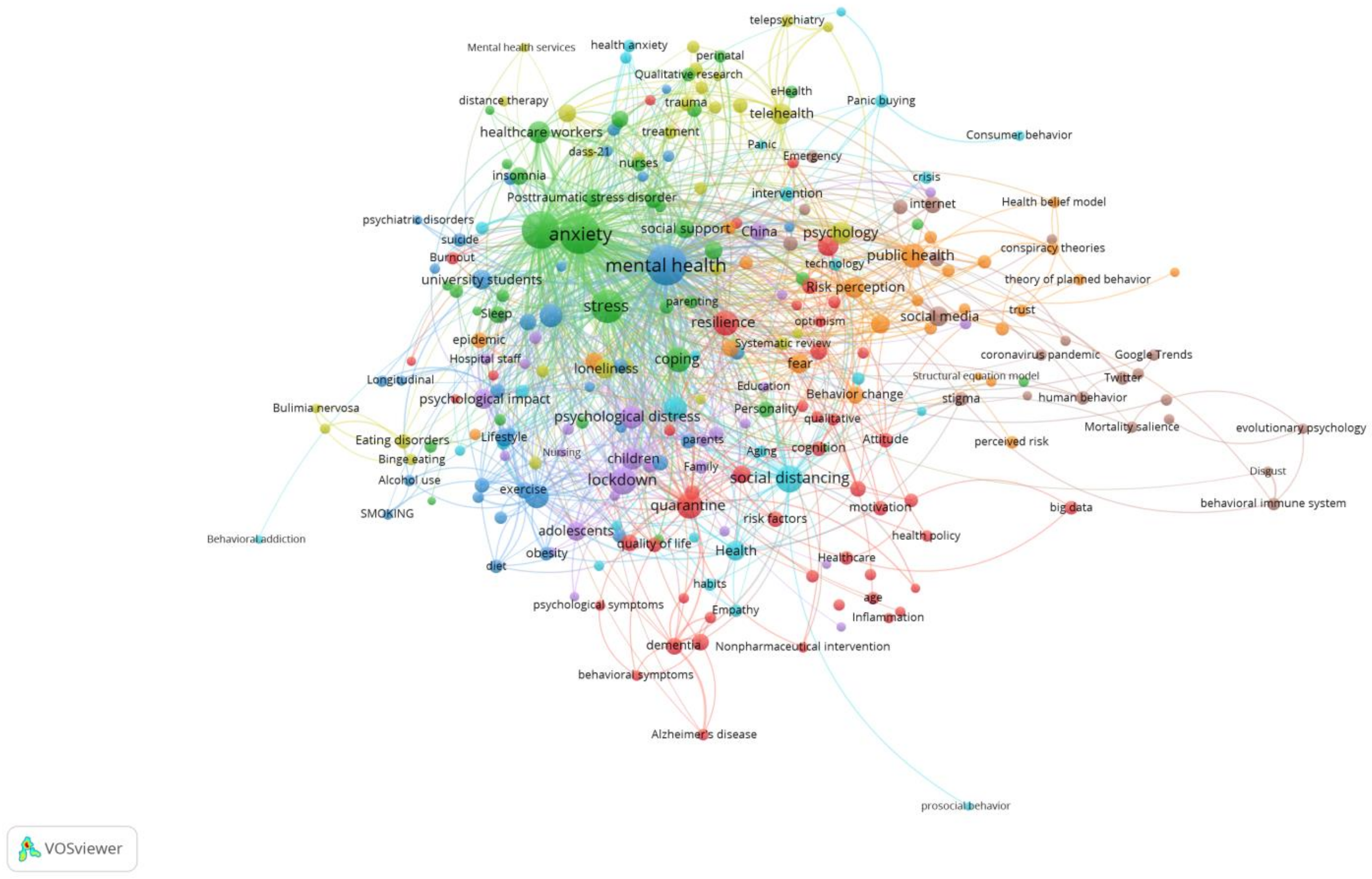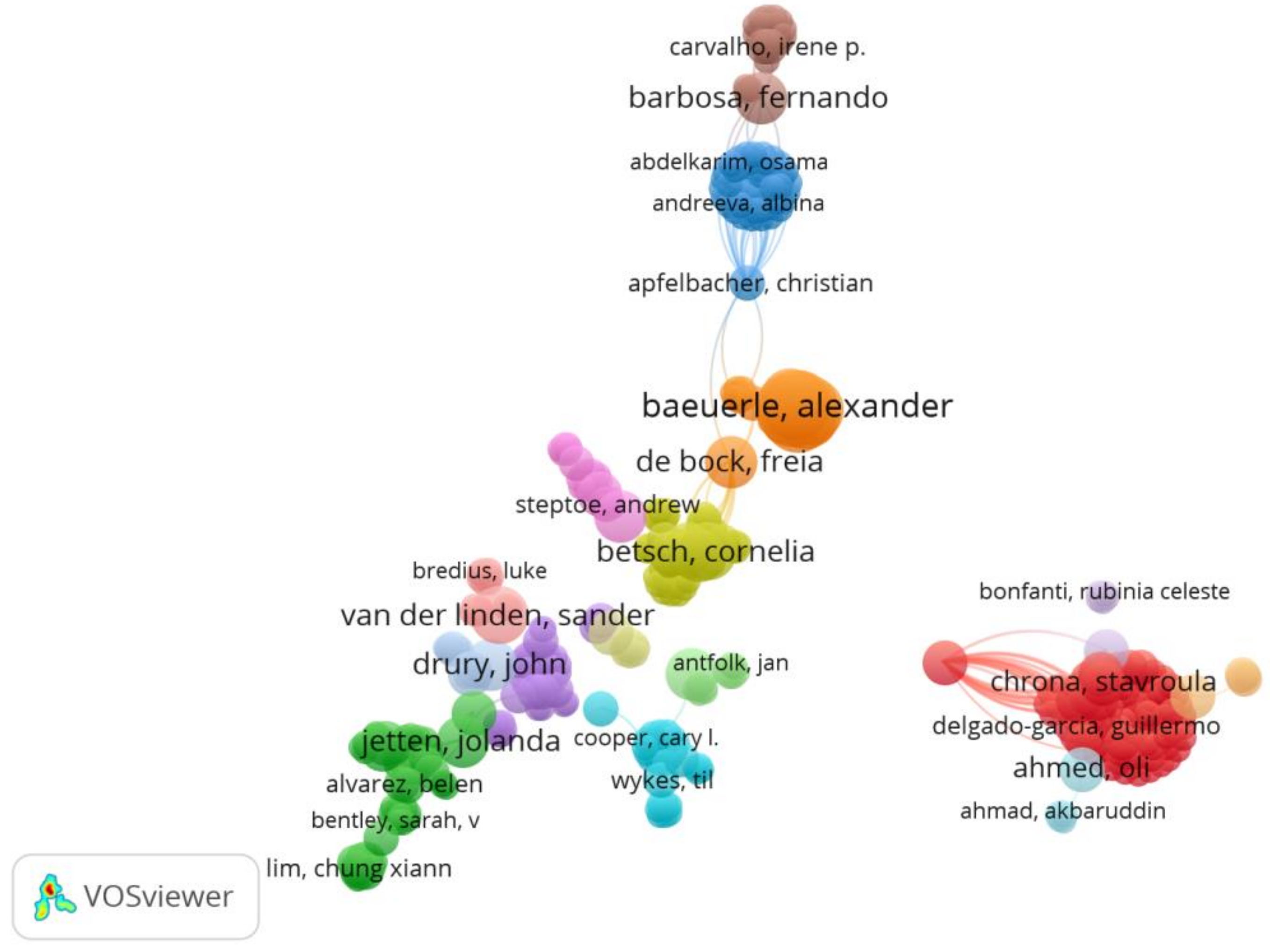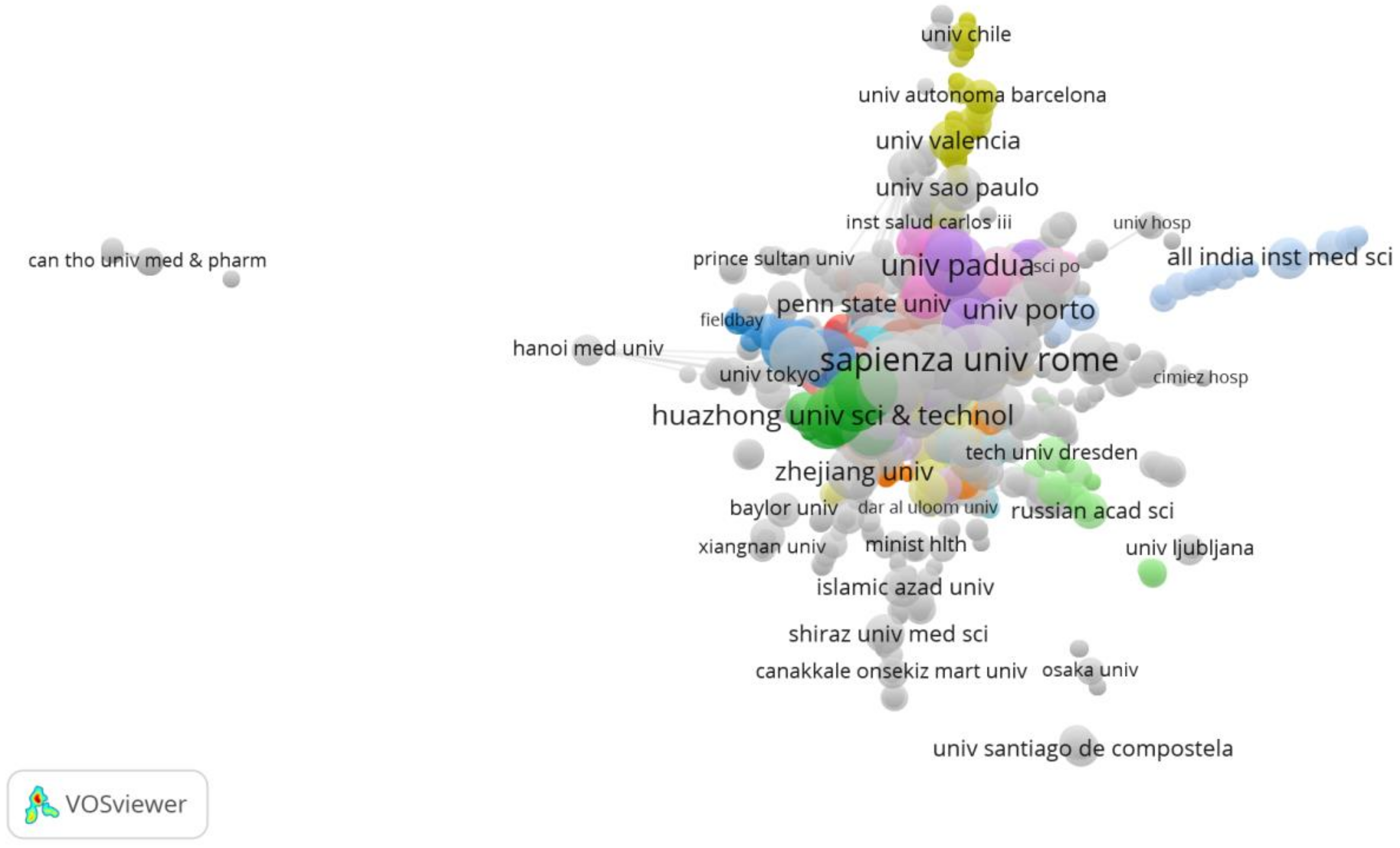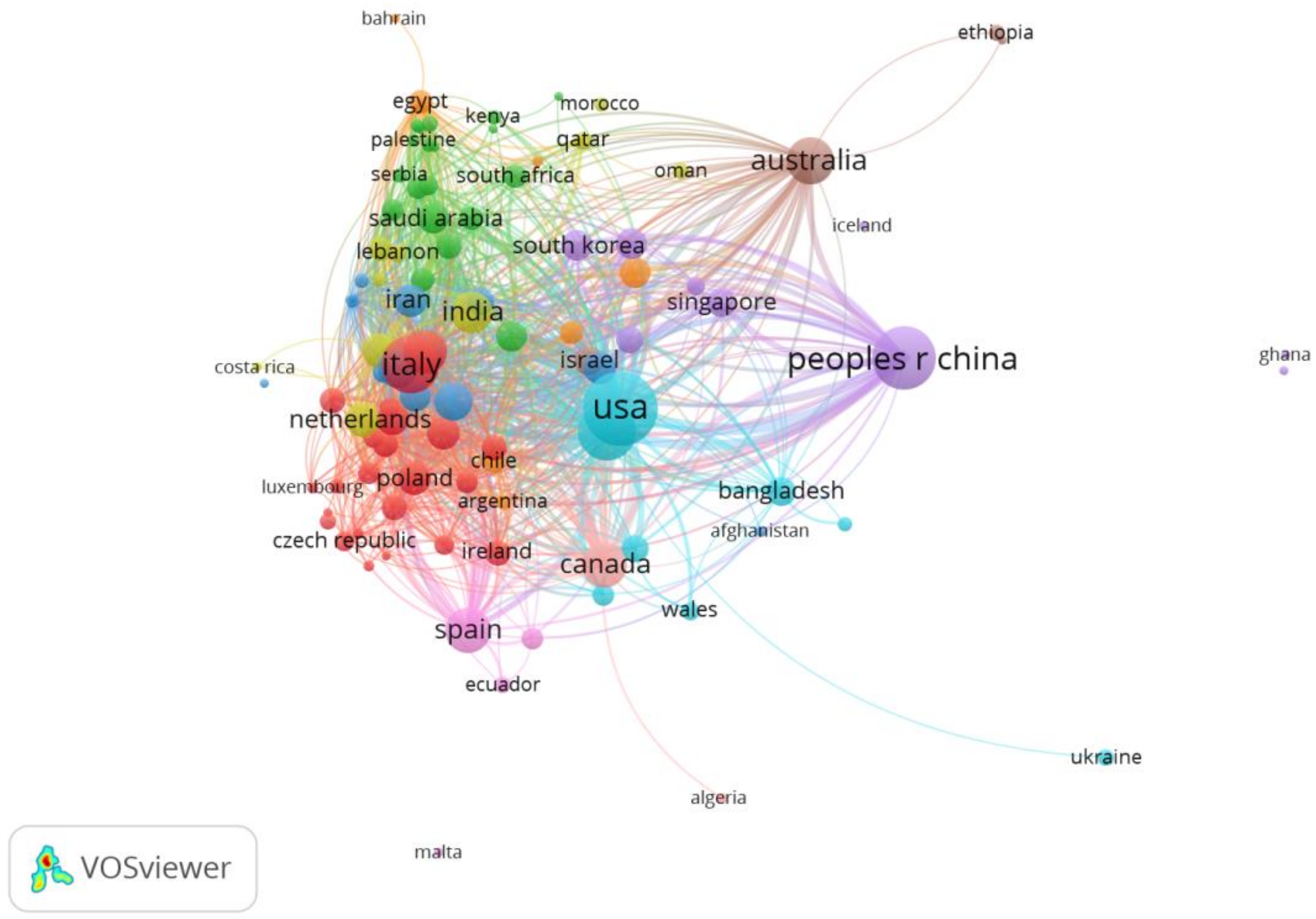A Bibliometric Analysis on Global Psychological and Behavioral Research Landscape on COVID-19 Pandemic
Abstract
:1. Introduction
2. Literature Review
3. Methodology
3.1. Data Source and Search Strategies
3.2. Bibliometric Tool and Functions
4. Results
4.1. Research Focus
4.2. Research Collaboration
5. Discussion and Limitation
6. Conclusions
Author Contributions
Funding
Institutional Review Board Statement
Informed Consent Statement
Data Availability Statement
Acknowledgments
Conflicts of Interest
References
- Correia, S.; Luck, S.; Verner, E. Pandemics Depress the Economy, Public Health Interventions Do Not: Evidence from the 1918 Flu. SSRN Electron. J. 2020, 14, 34–39. [Google Scholar] [CrossRef]
- Atkeson, A. What Will Be the Economic Impact of COVID-19 in the US? Rough Estimates of Disease Scenarios; NBER Working Papers 26981; National Bureau of Economic Research: Cambridge, MA, USA, 2020. [Google Scholar]
- Chen, H.; Qian, W.; Wen, Q. The Impact of the COVID-19 Pandemic on Consumption: Learning from High-Frequency Transaction Data. AEA Pap. Proc. 2021, 111, 307–311. [Google Scholar] [CrossRef]
- Hoffman, D.L.; Novak, T.P.; Schlosser, A. The Evolution of the Digital Divide: How Gaps in Internet Access May Impact Electronic Commerce. J. Comput. Commun. 2006, 5, JCMC534. [Google Scholar] [CrossRef]
- Alvarez, F.; Argente, D.; Lippi, F. A Simple Planning Problem for COVID-19 Lockdown; NBER Working Papers 26981; National Bureau of Economic Research: Cambridge, MA, USA, 2020. [Google Scholar]
- Kraemer, M.; Yang, C.; Gutierrez, B.; Wu, C.; Klein, B.; Pigott, D.; Scarpino, S. The effect of human mobility and control measures on the COVID-19 pandemic in China. Science 2020, 368, 493–497. [Google Scholar] [CrossRef] [Green Version]
- Guo, F. The role and deficiencies of digital economy in the COVID-19 pandemic: A literature review. Rev. Ind. Econ. 2021, 1, 34–49. (In Chinese) [Google Scholar]
- Jones, C.; Philippon, T.; Venkateswaran, V. Optimal Mitigation Policies in a Pandemic: Social Distancing and Working from Home. Rev. Financ. Stud. 2021, 34, 5188–5223. [Google Scholar] [CrossRef]
- Berger, D.; Herkenhoff, K.; Mongey, S. An SEIR Infectious Disease Model with Testing and Conditional Quarantine; Working Papers 2020-25; Becker Friedman Institute for Research in Economics: Chicago, IL, USA, 2020. [Google Scholar]
- Greenstone, M.; Nigam, V. Does Social Distancing Matter; Working Papers 2020-25; Becker Friedman Institute for Research in Economics: Chicago, IL, USA, 2020. [Google Scholar]
- Verhoeven, V.; Tsakitzidis, G.; Philips, H.; Van Royen, P. Impact of the COVID-19 pandemic on the core functions of primary care: Will the cure be worse than the disease? A qualitative interview study in Flemish GPs. BMJ Open 2020, 10, e039674. [Google Scholar] [CrossRef]
- Cinelli, M.; Quattrociocchi, W.; Galeazzi, A.; Valensise, C.M.; Brugnoli, E.; Schmidt, A.L.; Zola, P.; Zollo, F.; Scala, A. The COVID-19 social media infodemic. Sci. Rep. 2020, 10, 16598. [Google Scholar] [CrossRef]
- Maunder, R.; Hunter, J.; Vincent, L.; Bennett, J.; Peladeau, N.; Leszcz, M.; Sadavoy, J.; Verhaeghe, L.M.; Steinberg, R.; Mazzulli, T. The immediate psychological and occupational impact of the 2003 SARS outbreak in a teaching hospital. Can. Med. Assoc. J. 2003, 168, 1245–1251. [Google Scholar]
- Robertson, E.; Hershenfield, K.; Grace, S.; Stewart, D.E. The Psychosocial Effects of Being Quarantined following Exposure to SARS: A Qualitative Study of Toronto Health Care Workers. Can. J. Psychiatry 2004, 49, 403–407. [Google Scholar] [CrossRef] [Green Version]
- Bueno-Notivol, J.; Gracia-García, P.; Olaya, B.; Lasheras, I.; López-Antón, R.; Santabárbara, J. Prevalence of depression during the COVID-19 outbreak: A meta-analysis of community-based studies. Int. J. Clin. Health Psychol. 2021, 21, 100196. [Google Scholar] [CrossRef]
- Ettman, C.K.; Abdalla, S.M.; Cohen, G.H.; Sampson, L.; Vivier, P.M.; Galea, S. Prevalence of Depression Symptoms in US Adults Before and During the COVID-19 Pandemic. JAMA Netw. Open 2020, 3, e2019686. [Google Scholar] [CrossRef]
- Neece, C.; McIntyre, L.L.; Fenning, R. Examining the impact of COVID-19 in ethnically diverse families with young children with intellectual and developmental disabilities. J. Intellect. Disabil. Res. 2020, 64, 739–749. [Google Scholar] [CrossRef]
- Jiao, W.; Wang, L.; Liu, J.; Fang, S.; Jiao, F.; Pettoello-Mantovani, M.; Somekh, E. Behavioral and Emotional Disorders in Children during the COVID-19 pandemic. J. Pediatr. 2020, 221, 264–266. [Google Scholar] [CrossRef]
- Tian, F.; Li, H.; Tian, S.; Yang, J.; Shao, J.; Tian, C. Psychological symptoms of ordinary Chinese citizens based on SCL-90 during the level I emergency response to COVID-19. Psychiatry Res. 2020, 288, 112992. [Google Scholar] [CrossRef]
- Ahmed, M.; Ahmed, O.; Aibao, Z.; Hanbin, S.; Siyu, L.; Ahmad, A. pandemic of COVID-19 in China and associated Psychological Problems. Asian J. Psychiatry 2020, 51, 102092. [Google Scholar] [CrossRef]
- Şahin, M.K.; Aker, S.; Sahin, G.; Karabekiroğlu, A. Prevalence of Depression, Anxiety, Distress and Insomnia and Related Factors in Healthcare Workers during COVID-19 Pandemic in Turkey. J. Community Health 2020, 45, 1168–1177. [Google Scholar] [CrossRef]
- Liu, Y. A review of research on children and adolescents’ mental health in the COVID-19 pandemic. Chin. J. Spec. Educ. 2020, 12, 89–96. (In Chinese) [Google Scholar]
- Jiang, Y. Individuals, society, the future-Western philosophers discuss the impact of the new crown pandemic. Philos. Anal. 2020, 11, 160–175. (In Chinese) [Google Scholar]
- Van Bavel, J.J.; Baicker, K.; Boggio, P.S.; Capraro, V.; Cichocka, A.; Cikara, M.; Crockett, M.J.; Crum, A.J.; Douglas, K.M.; Druckman, J.N.; et al. Using social and behavioural science to support COVID-19 pandemic response. Nat. Hum. Behav. 2020, 4, 460–471. [Google Scholar] [CrossRef]
- Aristovnik, A.; Ravšelj, D.; Umek, L. A Bibliometric Analysis of COVID-19 across Science and Social Science Research Landscape. Sustainability 2020, 12, 9132. [Google Scholar] [CrossRef]
- Lou, J.; Tian, S.J.; Niu, S.M.; Kang, X.Q.; Lian, H.X.; Zhang, L.X.; Zhang, J.J. Coronavirus disease 2019: A bibliometric analysis and review. Eur. Rev. Med. Pharmacol. Sci. 2020, 24, 3411–3421. [Google Scholar]
- Verma, S.; Gustafsson, A. Investigating the emerging COVID-19 research trends in the field of business and management: A bibliometric analysis approach. J. Bus. Res. 2020, 118, 253–261. [Google Scholar] [CrossRef]
- Oh, J.; Kim, A. A bibliometric analysis of COVID-19 research published in nursing journals. Sci. Ed. 2020, 7, 118–124. [Google Scholar] [CrossRef]
- Liu, N.; Chee, M.L.; Niu, C.; Pek, P.P.; Siddiqui, F.J.; Ansah, J.P.; Matchar, D.B.; Lam, S.S.W.; Abdullah, H.R.; Chan, A.; et al. Coronavirus disease 2019 (COVID-19): An evidence map of medical literature. BMC Med. Res. Methodol. 2020, 20, 177. [Google Scholar] [CrossRef]
- Tao, Z.; Zhou, S.; Yao, R.-Q.; Wen, K.; Da, W.; Meng, Y.; Yang, K.; Liu, H.; Tao, L. COVID-19 will stimulate a new coronavirus research breakthrough: A 20-year bibliometric analysis. Ann. Transl. Med. 2020, 8, 528. [Google Scholar] [CrossRef]
- Kambhampati, S.B.; Vaishya, R.; Vaish, A. Unprecedented surge in publications related to COVID-19 in the first three months of pandemic: A bibliometric analytic report. J. Clin. Orthop. Trauma 2020, 11, S304–S306. [Google Scholar] [CrossRef]
- Haghani, M.; Bliemer, M.C.; Goerlandt, F.; Li, J. The scientific literature on Coronaviruses, COVID-19 and its associated safety-related research dimensions: A scientometric analysis and scoping review. Saf. Sci. 2020, 129, 104806. [Google Scholar] [CrossRef]
- Dubey, S.; Biswas, P.; Ghosh, R.; Chatterjee, S.; Dubey, M.J.; Chatterjee, S.; Lahiri, D.; Lavie, C.J. Psychosocial impact of COVID-19. Diabetes Metab. Syndr. Clin. Res. Rev. 2020, 14, 779–788. [Google Scholar] [CrossRef]
- Cruz-Cárdenas, J.; Zabelina, E.; Guadalupe-Lanas, J.; Palacio-Fierro, A.; Ramos-Galarza, C. COVID-19, consumer behavior, technology, and society: A literature review and bibliometric analysis. Technol. Forecast. Soc. Chang. 2021, 173, 121179. [Google Scholar] [CrossRef]
- Al-Jabi, S.W. Current global research landscape on COVID-19 and depressive disorders: Bibliometric and visualization analysis. World J. Psychiatry 2021, 11, 253–264. [Google Scholar] [CrossRef]
- Soytas, R.B. A bibliometric analysis of publications on COVID-19 and older adults. Ann. Geriatr. Med. Res. 2021, 25, 197–203. [Google Scholar] [CrossRef]
- Wang, X.; Yang, J.; Su, M.; Guang, C.; Ma, J.; Hu, W. Biliometric analysis of psychological research on COVID-19 in China. Chin. J. Appl. Psychol. 2021, 27, 178–188. (In Chinese) [Google Scholar]
- Chen, C. Science Mapping: A Systematic Review of the Literature. J. Data Inf. Sci. 2017, 2, 1–40. [Google Scholar] [CrossRef] [Green Version]
- Leydesdorff, L.; Carley, S.; Rafols, I. Global maps of science based on the new Web-of-Science categories. Scientometrics 2012, 94, 589–593. [Google Scholar] [CrossRef] [Green Version]
- Ding, X.; Yao, J. Peer Education Intervention on Adolescents’ Anxiety, Depression, and Sleep Disorder During The Covid-19 Pandemic. Psychiatr. Danub. 2020, 32, 527–535. [Google Scholar] [CrossRef]
- Van Eck, N.J.; Waltman, L. Software survey: VOSviewer, a computer program for bibliometric mapping. Scientometrics 2010, 84, 523–538. [Google Scholar] [CrossRef] [Green Version]
- Van Eck, N.J.; Waltman, L. Citation-based clustering of publications using CitNetExplorer and VOSviewer. Scientometrics 2017, 111, 1053–1070. [Google Scholar] [CrossRef] [Green Version]
- Nieminen, P.; Carpenter, J.; Rucker, G.; Schumacher, M. The relationship between quality of research and citation frequency. BMC Med. Res. Methodol. 2006, 6, 42. [Google Scholar] [CrossRef] [Green Version]
- Ebrahim, N.A.; Salehi, H.; Embi, M.A.; Tanha, F.H.; Gholizadeh, H.; Motahar, S.M.; Ordi, A. Effective Strategies for Increasing Citation Frequency. Int. Educ. Stud. 2013, 6, 93. [Google Scholar] [CrossRef] [Green Version]
- Huang, C.; Wang, Y.; Li, X.; Ren, L.; Zhao, J.; Hu, Y.; Cao, B. Clinical features of patients infected with 2019 novel coronavirus in Wuhan, China. Lancet (Br. Ed.) 2020, 395, 497–506. [Google Scholar] [CrossRef] [Green Version]
- Gauntlett, L.; Amlôt, R.; Rubin, G.J. How to inform the public about protective actions in a nuclear or radiological incident: A systematic review. Lancet Psychiatry 2019, 6, 72–80. [Google Scholar] [CrossRef] [Green Version]
- Hong, Y.; Kim, J.-S.; Xiong, L. Media exposure and individuals’ emergency preparedness behaviors for coping with natural and human-made disasters. J. Environ. Psychol. 2019, 63, 82–91. [Google Scholar] [CrossRef]
- Yuan, S.; Liao, Z.; Huang, H.; Jiang, B.; Zhang, X.; Wang, Y.; Zhao, M. Comparison of the Indicators of Psychological Stress in the Population of Hubei Province and Non-Endemic Provinces in China During Two Weeks During the Coronavirus Disease 2019 (COVID-19) Outbreak in February 2020. Med. Sci. Monit. 2020, 26, 923767. [Google Scholar] [CrossRef]
- Liang, L.; Ren, H.; Cao, R.; Hu, Y.; Qin, Z.; Li, C.; Mei, S. The Effect of COVID-19 on Youth Mental Health. Psychiatr. Q. 2020, 91, 841–852. [Google Scholar] [CrossRef]
- Blake, H.; Bermingham, F.; Johnson, G.; Tabner, A. Mitigating the Psychological Impact of COVID-19 on Healthcare Workers: A Digital Learning Package. Int. J. Environ. Res. Public Health 2020, 17, 2997. [Google Scholar] [CrossRef]
- Groarke, J.M.; Berry, E.; Graham-Wisener, L.; McKenna-Plumley, P.E.; McGlinchey, E.; Armour, C. Loneliness in the UK during the COVID-19 pandemic: Cross-sectional results from the COVID-19 Psychological Wellbeing Study. PLoS ONE 2020, 15, e0239698. [Google Scholar] [CrossRef]
- Stanton, R.; To, Q.G.; Khalesi, S.; Williams, S.L.; Alley, S.J.; Thwaite, T.L.; Fenning, A.S.; Vandelanotte, C. Depression, Anxiety and stress during COVID-19: Associations with changes in physical activity, sleep, tobacco and alcohol use in Australian adults. Int. J. Environ. Res. Public Health 2020, 17, 4065. [Google Scholar] [CrossRef]
- Newby, J.M.; O’Moore, K.; Tang, S.; Christensen, H.; Faasse, K. Acute mental health responses during the COVID-19 pandemic in Australia. PLoS ONE 2020, 15, e0236562. [Google Scholar] [CrossRef]
- Shechter, A.; Diaz, F.; Moise, N.; Anstey, D.E.; Ye, S.; Agarwal, S.; Birk, J.L.; Brodie, D.; Cannone, D.E.; Chang, B.; et al. Psychological distress, coping behaviors, and preferences for support among New York healthcare workers during the COVID-19 pandemic. Gen. Hosp. Psychiatry 2020, 66, 1–8. [Google Scholar] [CrossRef]
- Cénat, J.M.; Noorishad, P.-G.; Kokou-Kpolou, C.K.; Dalexis, R.D.; Hajizadeh, S.; Guerrier, M.; Clorméus, L.A.; Bukaka, J.; Birangui, J.-P.; Adansikou, K.; et al. Prevalence and correlates of depression during the COVID-19 pandemic and the major role of stigmatization in low- and middle-income countries: A multinational cross-sectional study. Psychiatry Res. 2021, 297, 113714. [Google Scholar] [CrossRef] [PubMed]




| Indicators | Description |
|---|---|
| Database source | WoS core collection |
| Data indices | SCI-E, SSCI, AHCI, CPCI-S, CPCI-SSH, ESCI, CCRE, IC |
| Publication type | articles, review articles |
| Topic selection strategy | TS = (“COVID-19” OR “coronavirus disease 2019” OR “SARS-CoV-2” OR “2019-nCoV”) AND TS = (“behavio *”) AND TS = (“psycholog *”) |
| Record volume | 2096 |
| Record content | publication type, title, authorship, abstract, keywords, institution, country/region, journal, and citation frequency |
| Retrieval time | 16 November 2021 |
| Number | Keyword | Total Link Strength |
|---|---|---|
| 1 | mental health | 931 |
| 2 | anxiety | 857 |
| 3 | depression | 673 |
| 4 | stress | 494 |
| 5 | social distancing | 308 |
| 6 | lockdown | 289 |
| 7 | quarantine | 255 |
| 8 | resilience | 218 |
| 9 | coping | 213 |
| 10 | public health | 203 |
| Author | N | Author | N |
|---|---|---|---|
| Griffiths, Mark D. | 12 | Levita, Liat | 5 |
| Mamun, Mohammed A. | 10 | Martinez, Anton P. | 5 |
| Lin, Chung-ying | 9 | Mason, Liam | 5 |
| Baeuerle, Alexander | 7 | Mcbride, Orla | 5 |
| Musche, Venja | 7 | Mckay, Ryan | 5 |
| Schweda, Adam | 7 | Murphy, Jamie | 5 |
| Skoda, Eva-maria | 7 | Shevlin, Mark | 5 |
| Teufel, Martin | 7 | Stocks, Thomas V. A. | 5 |
| Karekla, Maria | 7 | Fink, Madeleine | 5 |
| Doerrie, Nora | 6 | Al Mamun, Firoj | 5 |
| Kohler, Hannah | 6 | Hosen, Ismail | 5 |
| Weismueller, Benjamin | 6 | Marchetti, Daniela | 5 |
| Pakpour, Amir H. | 6 | Verrocchio, Maria Cristina | 5 |
| Mazza, Cristina | 6 | Chen, I-hua | 5 |
| Roma, Paolo | 6 | Ben-ezra, Menachem | 5 |
| Wang, Xueqin | 6 | Betsch, Cornelia | 5 |
| Yuen, Kum Fai | 6 | Morales, Alexandra | 5 |
| Goodwin, Robin | 6 | Ranjan, Piyush | 5 |
| Graffigna, Guendalina | 6 | Salameh, Pascale | 5 |
| Bentall, Richard P. | 5 | Van Der Linden, Sander | 5 |
| Hartman, Todd K. | 5 | Yen, Cheng-fang | 5 |
| Organization Abbreviation | N | Organization Abbreviation | N |
|---|---|---|---|
| sapienza univ rome | 33 | univ hong kong | 17 |
| ucl | 31 | univ queensland | 16 |
| kings coll london | 23 | univ oxford | 16 |
| univ toronto | 22 | univ porto | 16 |
| chinese univ hong kong | 22 | harvard med sch | 16 |
| univ padua | 22 | univ new south wales | 16 |
| sun yat sen univ | 20 | chinese acad sci | 16 |
| univ cambrigde | 19 | univ michigan | 15 |
| huazhong univ sci & technol | 19 | harvard univ | 15 |
| nottingham trent univ | 18 | nyu | 15 |
| columbia univ | 18 | univ penn | 15 |
| natl univ singapore | 18 | wuhan univ | 15 |
| univ cattolica sacro cuore | 18 | jahangirnagar univ | 15 |
| univ milan | 17 |
| Country | N | Country | N |
|---|---|---|---|
| USA | 496 | South Korea | 41 |
| PRC | 304 | Saudi Arabia | 39 |
| England | 245 | Japan | 38 |
| Italy | 228 | Sweden | 36 |
| Australia | 136 | Russia | 36 |
| Spain | 121 | China Taiwan | 35 |
| Canada | 112 | Bangladesh | 34 |
| Germany | 107 | Singapore | 34 |
| India | 94 | Israel | 32 |
| Turkey | 77 | Malaysia | 30 |
| Brazil | 66 | Scotland | 28 |
| France | 56 | New Zealand | 25 |
| Netherlands | 54 | Austria | 24 |
| Pakistan | 49 | Denmark | 23 |
| Switzerland | 47 | Romania | 23 |
| Iran | 47 | Belgium | 22 |
| Poland | 46 | Ireland | 21 |
| Portugal | 43 | Norway | 21 |
Publisher’s Note: MDPI stays neutral with regard to jurisdictional claims in published maps and institutional affiliations. |
© 2022 by the authors. Licensee MDPI, Basel, Switzerland. This article is an open access article distributed under the terms and conditions of the Creative Commons Attribution (CC BY) license (https://creativecommons.org/licenses/by/4.0/).
Share and Cite
Dong, X.; Wei, X.; Shu, F.; Su, Q.; Wang, J.; Liu, N.; Qiu, J. A Bibliometric Analysis on Global Psychological and Behavioral Research Landscape on COVID-19 Pandemic. Int. J. Environ. Res. Public Health 2022, 19, 879. https://doi.org/10.3390/ijerph19020879
Dong X, Wei X, Shu F, Su Q, Wang J, Liu N, Qiu J. A Bibliometric Analysis on Global Psychological and Behavioral Research Landscape on COVID-19 Pandemic. International Journal of Environmental Research and Public Health. 2022; 19(2):879. https://doi.org/10.3390/ijerph19020879
Chicago/Turabian StyleDong, Xilu, Xuqiu Wei, Fei Shu, Qiang Su, Juntao Wang, Ning Liu, and Junping Qiu. 2022. "A Bibliometric Analysis on Global Psychological and Behavioral Research Landscape on COVID-19 Pandemic" International Journal of Environmental Research and Public Health 19, no. 2: 879. https://doi.org/10.3390/ijerph19020879
APA StyleDong, X., Wei, X., Shu, F., Su, Q., Wang, J., Liu, N., & Qiu, J. (2022). A Bibliometric Analysis on Global Psychological and Behavioral Research Landscape on COVID-19 Pandemic. International Journal of Environmental Research and Public Health, 19(2), 879. https://doi.org/10.3390/ijerph19020879





